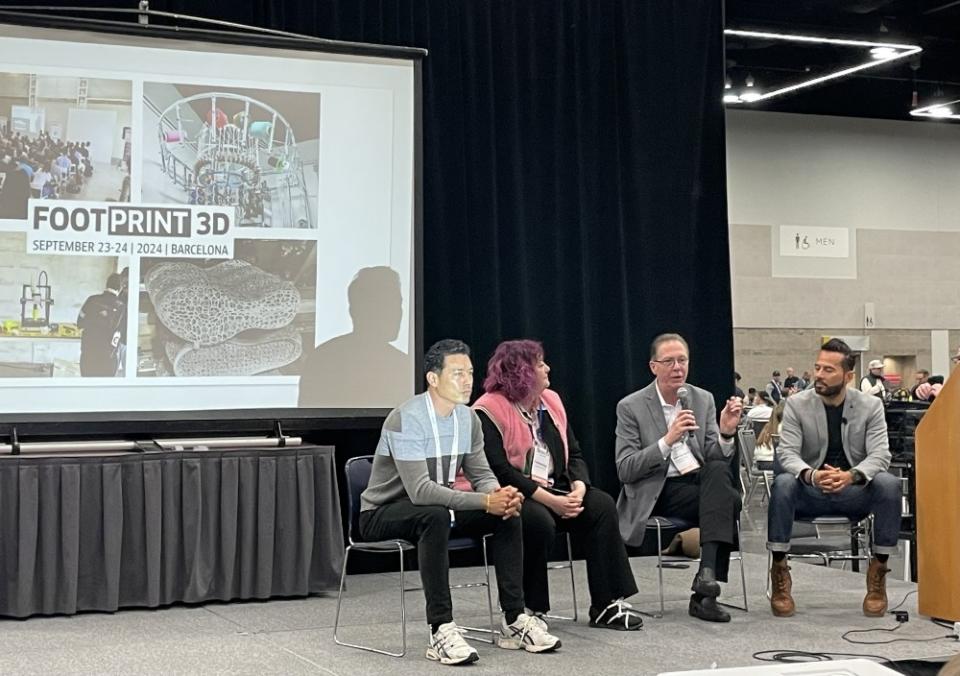Materials Show: 3D Knitting Could Revolutionize Footwear Production, Experts Say

Cutting-edge technology and innovative production processes have the potential to forever change the way footwear is made.
That’s according to industry innovators at the Materials Show in Portland, Ore., who spoke to the opportunities afforded by digital design and 3D knitting on Wednesday.
More from Sourcing Journal
“3D knitting as a method of manufacturing is an incredible platform to manufacture products with zero waste, and be very thoughtful about the materials you use and how you create that final product,” Garrett Gerson, CEO of 3D-knitting technology provider Variant 3D told an audience of global attendees.
Founded in in 2016, the company houses its own fleet of 3D-knitting machines at its headquarters in Malibu, Calif., collaborating with brands, suppliers and other boundary-pushing footwear innovators on product lines and capsule collections. In March, Variant 3D will launch a computer-aided design and computer-aided manufacturing (CAD-CAM) software with the goal of bringing 3D-knitting capabilities to the footwear industry and beyond.
The platform will make the design process for 3D-knitted products faster and more seamless. “You have to actually design pixel by pixel at the moment using traditional software,” Gerson explained. “What we’ll be able to do is import model file formats in 3D and create a full end-to-end [process] from design to creation, prototype and then into production.”
“We’ll be able to do it in minutes,” he added. Several large footwear firms—as well as players in the automotive and medical spaces—have already signed on to collaborate.
3D knitting provides myriad advantages, including speed and precision. The additive process ensures there are no cutting room scraps or production waste left over, Gerson said. Footwear uppers are knitted to exact specifications, and can be created with different structures and textile properties, all without subsequent sewing.

Northern Italy’s Santoni, Spa. develops the complex machinery needed to support 3D knitting. According to business development lead Patrick Silva Szatkowski, the century-old firm specializes in seamless knitting machinery specifically for socks and footwear uppers, offering a range of diameters depending on product specifications.
The company is introducing a large-diameter circular knitting machine that will allow producers to work with different types of yarns that can be placed on different parts of a product. “You can make an upper that is much more breathable, and you can customize completely your final product,” Szatkowski said. The production process is swift, ranging from 50 seconds to three minutes to create one shoe upper.
Santoni’s XT machine gives producers more options for sculpting and sizing a shoe’s upper. After the piece is knitted with a thermoplastic yarn, it can be heated to lend shape to the shoe. Certain parts of a shoe’s upper should be rigid while other zones should be more flexible for optimal functionality, Szatkowski said. The technology allows shoemakers to provide those features even when working with a one-piece upper and a single material.
Greensboro, N.C.-based machinery company Stoll is also using its flatbed knitting technology for applications in the footwear space, according to director of sales and marketing Matthew Llewellyn.
“You might think of flatbed knitting more for fashion sweaters, but it’s only a small part of what we actually do,” he said. The group, which is owned by the Karl Mayer Group, also lends its capabilities to the automotive and medical industries. Stoll’s circular flatbed knitting technology has been used in the footwear sector for years, he added.
The uppers are knit to shape and subsequently molded onto the sole of the shoe. “The advantage to that is zero waste,” Llewellyn said. “You can inlay yarns and you can insert different types of material.” A yarn might be added to a certain zone of the shoe’s upper in order to provide directional stretch, for example.
The firm also recently demonstrated how its Knitrobotics knitting process can insert NFC chips into knit textiles to create a digital product passport. “That could be utilized for factory purposes for traceability, it could be used for consumers to know where it was made, how it was made, how to wash and also now how to recycle,” he added.
Nicoline van Enter, founder and chief technology officer of Barcelona-based footwear academy Footwearology said the group’s goal is to reinvent the industry’s supply chain through research and development.
The group focuses on upskilling footwear professionals seeking training in new technologies, “whether this is software, manufacturing, material or understanding end-of-life systems,” she said. Footwearology conducts company training sessions as well as webinars and private classes.
“This is all stuff that is new,” and many industry veterans may not have had the chance to receive training in the field as of yet, van Enter said. “It really pushes the limits of what can be done.”
Solve the daily Crossword

